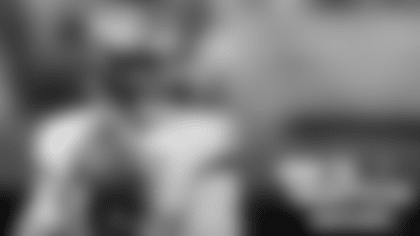The Tampa Bay Buccaneers didn't address the offensive line with any of their eight 2019 draft picks, but it would be a bit misleading to say the same about free agency.
That's not a reference to the depth signing of Earl Watford, the former Arizona Cardinal and Cleveland Brown who could compete for a starting spot or stick as a versatile super-sub. No, the most significant thing the Buccaneers did for their offensive line in free agency actually occurred about a week before the market opened. Rather than let Donovan Smith test unrestricted free agency or go the franchise tag route with their starting left tackle, the Buccaneers re-signed Smith to a new three year deal.
That was on March 5. The next day, the Bucs exercised their 2019 contract option on Demar Dotson, the starting right tackle in 2018. And, if one wants to rewind things a little bit more, rising-star guard Ali Marpet got a lucrative new deal last fall and starting center Ryan Jensen got the same thing last March. The Buccaneers have indeed put a lot of resources into their starting offensive line; now it's up to Bruce Arians and his new coaching staff to get the most out of those resources.
"That just speaks volumes for the guys we have in the room," said Run Game Coordinator Harold Goodwin. "We're going to rely on them. We're going to find five guys, seven at the most for game day, and I'm going to do everything I can to get the most out of them. But for them, you have to feel good about yourself because that means Jason believes in you, BA [Arians] believes in you, because we didn't take anybody. We've just got to make sure we keep grinding, get better."
The Buccaneers did make some significant additions and subtractions at other spots on the depth chart, of course. That work is mostly done; the 90-man camp roster could be tweaked here and there between the current run of OTAs and the coming training camp in late July, but most of the pieces are now in place. As such, we are taking a position-by-position look to see how things have changed and where the Bucs stand at each corner of the depth chart heading into the new season. We'll provide an overview of the assets at the position, discuss what some of the numbers from last season indicate about its strengths and weaknesses and then finish with that aforementioned burning question.
We're in the last of three weeks dedicated to the offensive side of the ball, which began with the quarterbacks and running backs and last week moved on to the wide receivers and tight ends. We'll hit the offensive line this week, starting with the guys on the edges: Offensive Tackles.
Addition(s): Riley Mayfield (undrafted free agent), Brock Ruble (undrafted free agent)
Subtraction(s): Leonard Wester (free agent, signed with Jacksonville)
Returning Players: Caleb Benenoch, Cole Boozer*, Demar Dotson, Mike Liedtke, Donovan Smith
(* Boozer was on the practice squad at the end of the 2018 season.)
We have chosen to include Liedtke with the tackles even though he's one of a handful of players who could be tried both inside and out. At the end of last season, Mike Liedtke was listed as the backup at left tackle on the depth chart, though it was the since-departed Leonard Wester who served as the third "swing" tackle behind the two starters. Alex Cappa and the aforementioned Watford are other players who could get work on the outside but we'll include them with the interior linemen later in the week.
General Manager Jason Licht made it clear after the deal was done with Smith that the team would have turned to the franchise tag otherwise in order to keep their left tackle in the building. Smith has started every game and played virtually every offensive snap in his first four seasons in the NFL, at one of the game's most demanding and important positions, and that alone has given the former second-round pick tremendous value. But Licht also made it clear that he thinks Smith still has a significant amount of untapped potential, and that the Bucs hope he remains in that left tackle spot beyond this current three-year deal.
"Donovan, in addition to being a massive person has a great, great combination of athleticism, strength – but more importantly his intelligence and his desire to be out on the field every Sunday," said Licht. "I think that gets talked about a lot, but at the same time doesn't get talked about enough. That's a quality that's hard to find, especially with his leadership and the respect that he has from his teammates for loving the game, wanting to be better, and wanting to get better every day. So, in addition to getting and securing him for the next – you know he signed a three-year contract - he also has a tremendous upside still. I'm looking forward to him reaching that potential in the next few years."
On the other end of the line is the team's longest-tenured player, as Demar Dotson first arrived as an undrafted tryout player in 2009. Though injuries robbed Dotson of most of the 2015 season and a handful of games in the last three years, he has essentially manned that right tackle spot since the start of 2012. He's continued to play at a high level in recent years when healthy.
"We try not to pin him up," said Goodwin. "In football terms he's an old man but he still moves well. He's learning the offense just like everybody else. I'm very pleased to see him. He doesn't smile a lot, not a man of many words I'm starting to learn, but he still has some tread on the tires. Hopefully we can get something out of him."
Benenoch was a starter last year, too, but at right guard. The Buccaneers now think he's better suited to play tackle, where he had a nice run at the end of the 2017 season when Dotson got hurt. Assuming good health and continued strong play from Smith and Dotson, Benenoch could slide into that swing tackle role previously held by Wester, who was not given a tender offer to make him a restricted free agent this past spring.
Liedtke could end up providing the same sort of inside/outside depth he gave the Buccaneers last year. The only other additions to the tackle position are a pair of undrafted rookies in North Texas' Riley Mayfield and Toledo's Brock Ruble. Both have great size but, of course, are untested. It's far too early to guess which of the team's undrafted rookies have a real shot at the roster, but the team certainly has a track record of finding depth in that manner, from Dotson to Liedtke and many in between.
"It's hard to really tell what we truly have until we put on shoulder pads, concluded Goodwin. "But so far, so good. We still have a long way to go and every day we're just trying to get better."
And, again, there were no additions to this group or the interior line in the draft, which is simply a matter of limited resources. It's impossible to hit every depth chart need with seven or eight picks, especially when the later round picks are increasingly longer shots. That said, the Buccaneers were giving consideration to adding young talent to the line during draft weekend.
"I think the one thing that Jason and BA did a great job on was, we didn't reach," said Offensive Line Coach Joe Gilbert. "At the end of the day we had our list of guys that we wanted and felt could come in here in the system we're going to run and really help us. The last thing we want to do is go for a guy that doesn't fit what we're going to do, or we didn't feel had the tools to do what we're going to do, and now you're stuck with him. I think from that standpoint they made the right decisions. We were just a pick off from addressing it, maybe getting a guy or two there, and it just didn't fall the right way."
Notable 2018 Numbers: The Buccaneers finished the 2018 season first in passing yards, third in total net yards and 12th in scoring, and it would simply be impossible to do all of that without some proficiency from the offensive line. As coaches are wont to say, it all starts up front.
So that's where we start with an offensive line that is returning nearly intact from last year: They were an integral part of a high-powered attack. That said, there were some obvious shortcomings to that offense, as well, for which the O-Line must help shoulder the blame. The biggest and most obvious one is that the Buccaneers simply had trouble running the football with any consistency. Tampa Bay was 29th in rushing yards per game and 31st in yards per carry, continuing a three-year stretch in which the ground game was less effective than had been hoped.
The Buccaneers' pass protection was good in 2018. The blockers got help from a quarterback in Jameis Winston who continues to get better at extending plays and making moves on the run. On the flip side, however, Tampa Bay's linemen had a tougher job than some of their peers around the league because the Bucs relied on a lot of passing plays that took longer to develop. Blocks had to be held longer. Put it all together and a ranking of 11th in sacks allowed per pass attempt is likely an accurate measurement of how well Winston was protected.
Tampa Bay's offense piled up a lot of yardage – 415.5 per game – in 2018 and didn't often hurt itself with plays that took away from that total. The Buccaneers had 38 running plays that lost yards, five completions that lost yards and 36 sacks allowed. That's a total of 79 negative-yardage plays, the 10th-lowest total in the NFL. The offensive line deserves a lot of credit for that low mark.
On the flip side of that, the Buccaneers' offense only gained four yards or more on 20.6% of their running plays on first down. That obviously creates longer second and third downs and makes it harder to sell play-action fakes on those subsequent downs. As Goodwin has said in discussing the rushing game the Bucs hope to create in 2019, the first goal is "four or more" – get at least four yards on every run (or the yards necessary for a first down in short-yardage situations) and then let the bigger plays come.
Key Question: Will the running game improve with a new scheme?
The Buccaneers will have a different running game under Arians and Goodwin, and hopefully that in itself will make a difference. Falling into early deficits – a problem last year – less often would probably help in this cause as well. Improvement from young backs Peyton Barber and Ronald Jones would be a plus. But in some respects, a step forward in the rushing game is in the hands of Goodwin and Gilbert, who will push the linemen to assert their will over their opponents.
"Someone's got to win a one-on-one block," said Gilbert. "We can't double-team every guy inside. It's the same thing in pass protection. You're going to slide, you're going to try to take into account, 'Hey, who are their great pass-rushers.' But at the end of the day, somebody has to win a one-on-one block, me against you. And who wants it more? It may not always be pretty, but I've got to instill my will over you. Those guys up front, there aren't any shortcuts for them."
Arians' "no risk it, no biscuit" motto makes it clear that he intends to push the ball downfield aggressively in the passing game. But that doesn't mean he favors an unbalanced offense like the one the Buccaneers unfortunately ended up with last year. A rushing game that poses a believable threat to the opposing defense will serve to open up more opportunities to get those big-play biscuits.
"We want to be great," said Goodwin of the Bucs' offensive line. "Obviously, here in the past from what I've been told, the running game hasn't been great, and we know we have to improve that. Without the running game I don't think you can do much in the passing game because we've got to set up the play-action pass just be running it, so we have to be better at that."

























